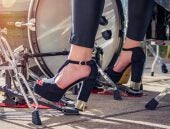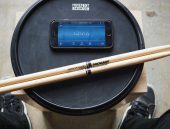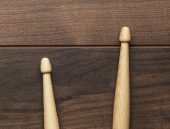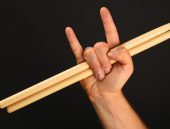Metal Drummers: Learn More With the Right Gear & Exercises
Published on Wednesday 12 February 2025

Trash metal, metalcore, djent, death metal, doom metal, grindcore, nu-metal, speed metal… Metal has at least 666 subgenres to it, and every last one of them has its own distinct characteristics. But when you want to be a metal drummer, there are some solid basics you can learn to help you cover all of them. In this blog, you’ll find out what you need to know and what kind of exercises you need to be drilling so that, after all your hard work, you can truly call yourself a metal drummer and join the immortal ranks of the anti-gods.
The Right Drum Kit
The kind of drum kit you’re playing doesn’t actually matter too much. There are, of course, metal drummers who build thirteen-piece walls of drums and cymbals around themselves, and then there are drummers who are quite happy with just four shells. Basically, as long as you’re happy with your kit and you enjoy playing it, then you’ve got everything you need. In general, the shell-sizes tend to be a bit bigger in metal than in other genres, but they definitely don’t have to be. It’s all about what you want, so if you need a more full and bulky sound out of your toms, then you might want to go for deeper models. If you prefer a more defined sound so you can actually hear the finer nuances of your playing, then you might prefer to go for shallower toms (personally, I’m really happy with my 10 inch tom, which is just 6.5 inches deep). The only thing that most metal drummers do agree on is the bass drum which, under no circumstances, should ever be too small. You’re never going to get a good, powerful accent out of a 16 inch kick drum. Instead, you’re going to need a kit with a 20 inch or 22 inch bass drum.

The Right Sticks
A factor that will have an impact on your playing is, of course, the type of drumsticks you’re playing with. The common theme in all of the subgenres of metal is that everything is played super hard, so you need to make sure you’re playing with a set of sticks that will survive. This doesn’t mean that you have to play with an ultra-thick set of 2Bs with an extra-short taper, but it does mean that you can’t get away with anything thinner than a pair of 5B sticks – that’s the absolute minimum. Any thinner, and your sticks will be breaking daily, and before they break, they won’t be able to get near-enough power out of the snare to play a good backbeat.
Whether or not you’ll need a shorter or longer taper will depend on which subgenre you’re taking on. If you’re playing death metal, then speed and power is of the essence, so you’ll need sticks with a shorter taper. Progressive metal will ask for a longer taper, because that’s what will give you all those subtle ghost notes. If you’ve yet to learn all the ins and outs of the humble drumstick and want to know more about what to look for, then have a quick look at our Drumstick Buyer’s Guide.

The Right Drumheads
Single-ply drumheads have a really gorgeous and open sound to them but, unfortunately, that’s exactly what you don’t want if you’re playing metal. It’s a universal truth that a thicker drumhead will give you a thicker sound with more attack and less sustain, which is precisely what you need if you want to be able to hear every strike in every fill, no matter how fast you’re spitting them. So, if you’re looking for new drumheads, you’ll want to get dual-ply drumheads (or some really thick single-ply drumheads). One of the perks of thicker drumheads is that they also last a bit longer, meaning that they’re also a better choice for your poor drummer’s wallet. Whether you go for coated or clear drumheads, it doesn’t really matter: with a coating, your sound will be a touch warmer, and without a coating, it’ll be a touch brighter, so it all comes down to what you prefer. You can find more info about picking the right drumheads in this blog and, if you’re having trouble tuning your drums, you’ll also find some helpful instructions here.

The Right Dampening
It might sound a bit weird when we’re talking about music that’s all about the decibels, but dampening is actually really important. It’s not about lowering the volume, but about sort of filtering out the overtones and making your sound as compact as it can get (and making sure that your drums sound better than they do on St. Anger). You can get drumheads with in-built dampening, like a damping ring or an extra layer that’s stuck in the centre. Still, it definitely can’t hurt to add an extra dampening ring to your bass drum or to stick a couple of gels on your snare and toms, so you can take a drony or even ‘singing’ drum sound and transform it into a bone-shaking sledgehammer.

The Right Cymbals
If you want some help picking out the right cymbals and you’re interested in learning how to keep them healthy for as long as possible, head over to my other blog, How to Make Your Cymbals Last Longer? However, generally speaking, it’s smart for most metal drummers to go for cymbals with a brilliant finish because they have much more projection and a much sharper, clearer sound than cymbals with any other kind of finish. A bigger, shinier cymbal sound is exactly what’s going to make your drumming clearly audible over all of that guitar noise. You simply can’t pull it off with cymbals that are drowned out by everything else in the band mix. Of course, like anything, it’s all about what you prefer, so ultimately, you want to get some cymbals that you love the sound of and that work really well with the sound of the rest of your kit.
The only thing I really recommend is kitting yourself out with is a china cymbal, which is actually much more versatile than it might sound. China cymbals have a really short and aggressive response that’s perfect for big and biting accents, which you can also pack plenty of variation into. But it can also serve as a rhythm cymbal and, in fact, it’s a common trick to smack a china on every count during breakdowns. To give your kit sound a bit of variety, I also recommend getting a second crash that you can use a rhythm cymbal but, of course, you’ll do just fine with a basic cymbal pack and getting creative with the sound of what you’ve got.

The Right Double Kick Pedal
Almost every metal drummer on Earth wouldn’t be seen without two kick pedals or a double kick pedal. In fact, one of the only metal drummers in the business that hasn’t stepped over to a double kick is Nicko McBrain from Iron Maiden. If using a double kick is all new to you, I’ve included a bunch of short exercises you can try out to help train your left foot to move alongside your right foot. I recommend starting at a slow pace and only speeding up when you’ve properly nailed playing each exercise. For more tips on how to speed up your drumming in general, have a look at my other blog: How to Drum Faster.
Double Kick Exercises
I came up with all of these exercises on a right-handed drum kit, so if you play a left-handed setup, then whenever you see ‘right’, play left instead, and when you see ‘left’, play right instead. If you don’t fully understand any of the drum notation included below, then it might be a good idea to read these blogs on the subject before you get stuck in:
Exercise 1
I’m going to be honest with you. This exercise is actually really boring, but trust me, it’ll do brilliant things for your coordination and your left leg endurance. You’ll only be playing the kick on the second, fourth and sixteenth notes of each count, and on the 1. Play 1 with your right foot and all of the other notes with your left foot. The kick you play on the one with your right foot is your benchmark, so you can check that your left foot kick notes are just as tight.
Exercise 1:

Exercise 2
In this exercise, I’m adding a few extra kick hits. Now, you need to play every count with your right foot while continuing to play every second, fourth and sixteenth note of every count with your left foot.
Exercise 2:

Exercise 3
Here, you’re going to play every eighth note with your right foot while filling the second sixteenth of each beat with your left foot.
Exercise 3:

Exercise 4
Only when you’ve really nailed the previous exercise do I recommend going for the next one. For this one, you need to have practised enough to get your stamina up, so don’t say I didn’t warn you. It’s also really tempting to play this one really fast, but resist the urge. Dust off your metronome and start slowly!
Exercise 4:

Exercise 5
If a certain metal track demands a bit of swing, it’s worth being able to pull some triplets out of your toolbag. Just note: try to keep your playing neat as you alternate, playing the first and third count with your right foot and the second and fourth count with your left foot.
Exercise 5:

Of course, you’re welcome to combine the exercise above with your own beats. In the notation below, you can see an example of how you can combine different rhythms to build a breakdown. As you can see in the second bar, by combining metric and antimetric patterns (sixteenths and triplets in this case), we end up starting a beat on the wrong side. And all of that noise in the last bar? That’s a blast-beat, which you’ll read more about in Exercise 6.
Example – a combination of different rhythms building a breakdown:

Exercise 6
Now you’ve got some double kick skills under your belt, it’s time to do some heavier lifting: blast beats. Physically, this technique is really demanding, so again: start slow! If you force yourself too soon, you’ll risk injury so take it easy. The first blast beat is the easiest version, where you alternate between playing the snare with your left hand and playing the kick with your right foot, all while keeping the beat with your right hand.
Exercise 6a:

Oefening 6b:

Exercise 7
Here, you can hear a note on every eighth.
Exercise 7:

Exercise 8
In this exercise, you’re playing the sixteenths on the kick and the eighths with your hands. Is this one proving to be a bit too much of a challenge? Try it really, ridiculously slowly at first and build up (there’s also no shame in heading back to Exercise 4).
Exercise 8:

Exercise 9
Now the real work begins. Here, you’ll be playing every sixteenth on the kick and on your snare. You’ll also be playing every eighth of every sixteenth on a cymbal (or, if you’re a true master of the art, you’ll play the bell of your ride with your right hand). Again, don’t try launching in too fast or you’ll risk doing yourself damage. Remember: you’re here to learn so take it easy!
Exercise 9a:

Exercise 9b:

Exercise 9c:

Extra Playing Tips
- The fact that metal needs to be played loud doesn’t mean that you have to compromise on your technique. So, always make sure that every hit is clean and that you don’t, for example, start hitting ‘through your cymbals’ instead of stopping when you’ve struck the cymbal. Also make sure that you’re not squeezing your sticks any harder than you need to, otherwise you’ll risk causing injury.
- To give your snare more cutting power, it’s recommended to hit rim shots. So, at the same time as you hit the batter head, you’re also hitting the rim closest to where your hand is. This will give you much more volume and attack. The secret to getting a rim shot right without having to think about it is practice, practice… and more practice.
Now you’ve made it to the end of this blog, I hope you have a clearer picture of what it takes to be a metal drummer which, in most cases, involves a lot more than just smacking some drums. Because I’m mainly into progressive metal, I might have missed something that’s essential for other subgenres, so sorry about that. But if you do have any questions or tips to share, feel free to stick them in the comments.
See also
» Drumming in Irregular Time Signatures: Examples & Exercises
» Drum Fills for Beginners
» How to Make Your Cymbals Last Longer
» Independence Exercises for Drummers
» 5 Legendary Drum Parts
» How to Build Maximum-Impact Drum Solos
» How to Drum Faster
» Drum Kit Configurations: Try These Variations!
» Writing Your Own Drum Beats
» How to Hold Your Drumsticks
» What are the Four Most Important Drum Rudiments?
» The Four Most Important Drum Rhythms
» Drumheads: How to Get Perfect Tone
» What’s the Best Tom Drum for Me?
» What’s the Best Dampening Gear for My Drum Kit?
» What’s the Best Snare Drum for Me?
» What Are the Best Drum Heads for Me?
» What’s the Best Kick Drum Pedal for Me?
» What’s the Best Drum Kit for Me?
» What Are The Best Cymbals for Me?
» What Are the Best Drumsticks for Me?

















No comments yet...